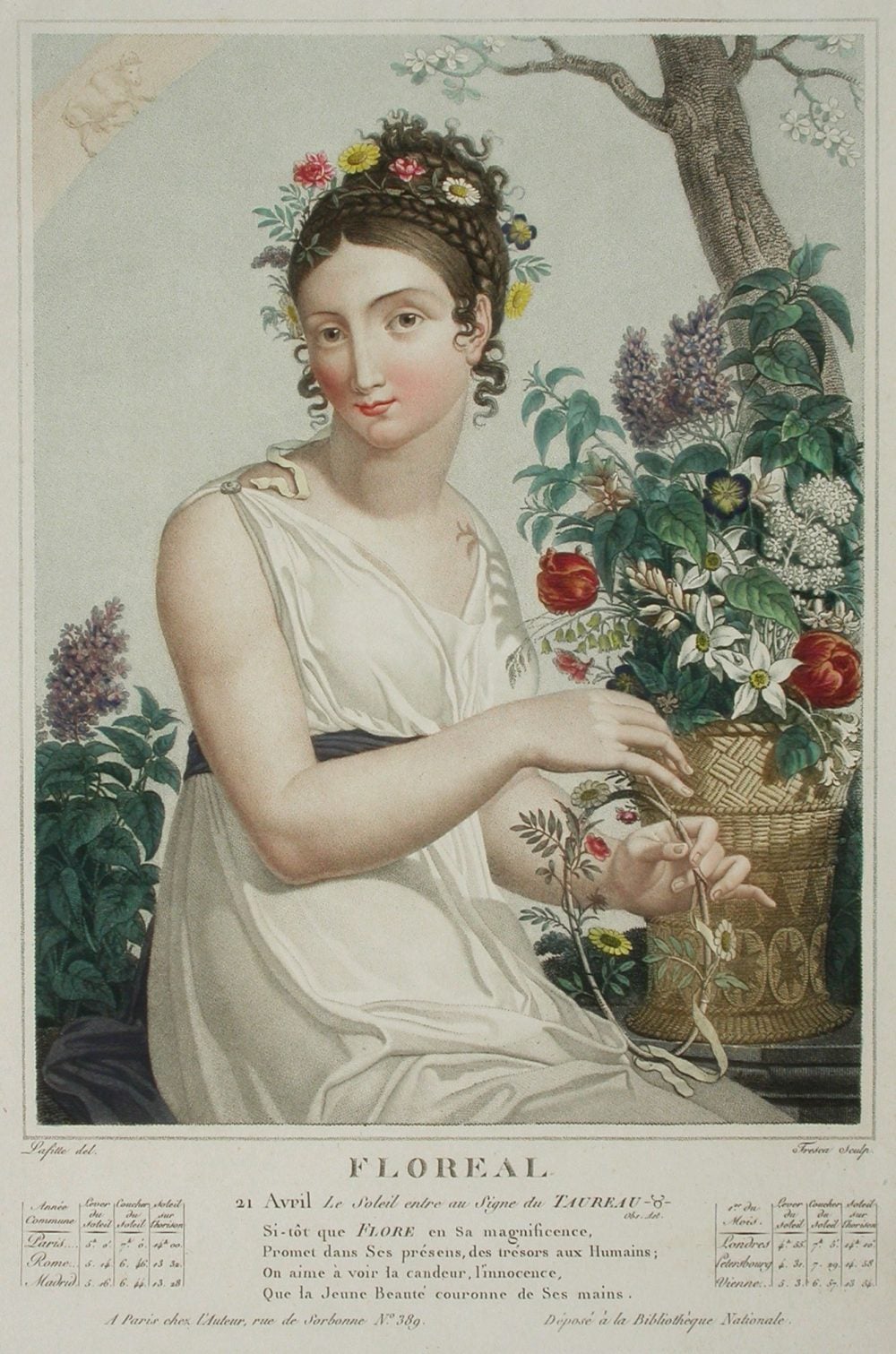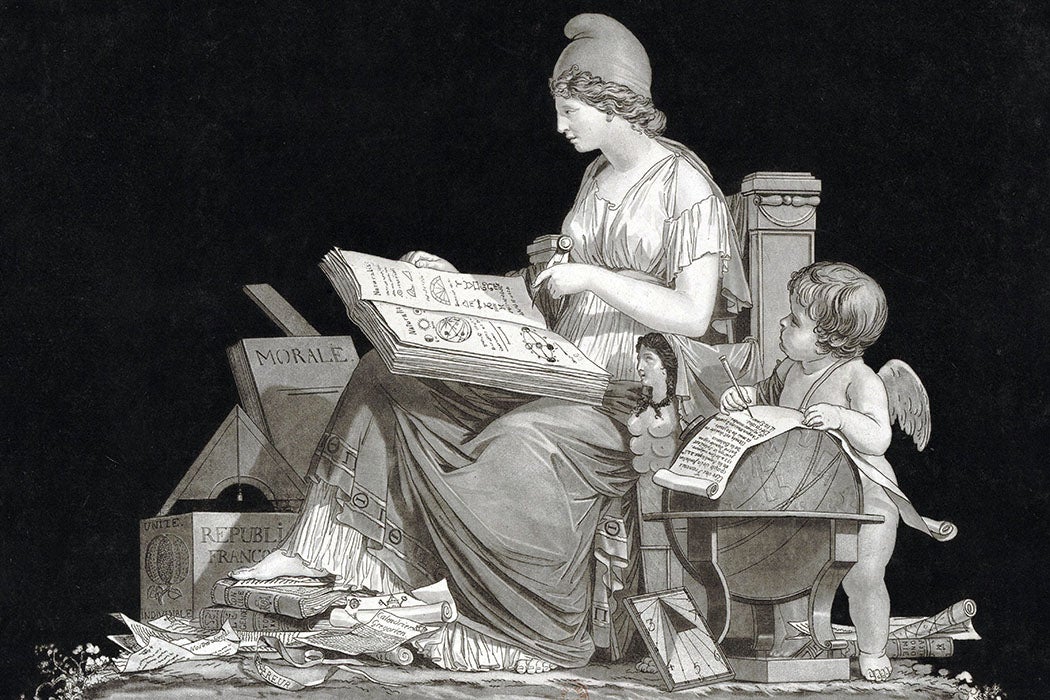The last time clocks were set and calendars hung according to the French Republican Calendar was some 147 years ago this month. For a glorious eighteen days, the Paris Commune resurrected the quixotic calendar of their revolutionary forebearers from a century before. From the 16th of Floréal to the 3rd of Prairal in the 79th Year of Liberty, citizens followed a decimal calendar. The revolutionary zeal to reform all aspects of society burned so intensely that it altered the very names of the days and months. As part of a project of rationalization and dechristianization, the new calendar marked the establishment of the first French Republic in 1792, the first year of the new order.
Want more stories like this one?
That last use of the revolutionary calendar, in 1871, the year of the Commune, saw the formation of Germany, the sixth year of Reconstruction in the United States, and the publication of George Eliot’s Middlemarch. In rocky Montmartre, overlooking the arrondissements of Paris, the radicals of the Commune were about to be violently suppressed by the government. But for two-and-a-half weeks, in May, they tried to reform time along rational lines, to exorcise our days of dead gods and saints. Their history shows that time resists such taming, and that the old gods are not so easily dispersed.
The sociologist Eviatar Zerubavel described the calendar in a 1972 issue of the American Sociological Review as “the most radical attempt in modern history to challenge the Western standard temporal reference framework.” There had been several amendments since the adoption of a Christian calendar in the sixth century. Most radically, the Gregorian Calendar, which corrected astronomical incongruities in the previous system. Initiated around 1582 by the Pope whose name it bears, it was adopted by Catholics and then slowly by Protestant and Orthodox states (with Russia a straggler well into the twentieth century).
The historian Robert Poole makes clear in Past & Present that anecdotes about an eighteenth century mob, distressed over the British Parliament’s deletion of a week and a half from the calendar (necessary to adopting the Gregorian system), yelling “Give us our eleven days!” are apocryphal. But the legend’s endurance exhibits how “cultural losses sustained when the… calendar was overturned” engendered resistance. How much more unsettling would it be when it was not just eleven days erased, but indeed Monday through Sunday, January through December, and the very years themselves?
* * *
The French Republican Calendar had radical precursors. A year before the Revolution, the notorious atheist Sylvain Maréchal designed his own system, eliminating the saint days of the Roman Catholic year and replacing Christmas with Newton’s December 25th birthday. A far more radical calendar would be established by the National Convention in 1793, or rather the Second Year of Liberty, as they backdated to when the First Republic was inaugurated. An auspicious autumnal equinox on what had once been September 21, 1792, now marked the first day of the new age.
Maréchal gave his full blessing, proudly declaring that “The calendar… must not resemble in any respect the official annuals of the apostolic and Roman church.” And so the New Years of the regime would be on “Primidi” (the first day of the week) of the first month of “Vendémiaire” (named for the grape harvest) in the First Year of Liberty. In Richard Carrigan’s article on decimal time from a 1978 American Scientist, he explains that the calendar was spearheaded by “Gilbert Romme, a forty-two-year-old delegate to the Convention with a bent for physics and mathematics.” Romme relied on advice from a “blue-ribbon scientific panel,” including chemist Louis-Bernard Guyton, mathematician Joseph-Louis Lagrange, and poet Fabre d’Églantine.

Zerubavel (the sociologist) writes that the calendar functioned as a “representation of three main themes of the French Enlightenment: secularism, naturalism and rationalism.” He observes that “the calendrical reform actually was viewed as an extension of the metric reform… [adopting] the decimal principle” as its basis. There are difficulties in a base-ten calendrical system. The Earth’s rotation and revolution are astronomical realities outside of human control. It would be easier to enact a decimal system on some interstellar spaceship not concerned with the motions of our solar system. Yet Romme performed the job admirably, making due with the actual motion of the Earth while hewing to metric simplicity.
His calendar still had twelve months, ranging from Vendémiaire to Fructidor, each composed of three weeks of ten days each, with the remaining five or six days at the end of the year constituting holidays called “Sansculottides,” in honor of the revolutionary working class. These were holidays dedicated to secular virtues, from talent to labor. Smaller divisions were also metrical, with days divided into ten hours each, of 100 minutes each, of 100 seconds each.
Watchmakers constructed mechanisms to compensate for the redefinitions. In revolutionary France, an hour was almost twice as long, a minute slightly longer, and a second slightly shorter. Not only were frustrated clockmakers flummoxed, but, as Zerubavel explains, the calendar intentionally disrupted “church-attending practices, since it presented both practical and cognitive difficulties in keeping up with the traditional, sacred seven-day cycle.” It also meant you had to wait nine days for a weekend instead of six.
Breaking the liturgical cycle was the precise idea. Charles A. Gliozzo writes in a 1971 Church History paper that a central goal was “not only to destroy an old faith, but to supply a new faith, which would be in conformity with the new age, to give a supreme significance to the rise of science, the growth of the State and the improvement of civilization.”
Romme attempted complete secularism by recourse to a type of naturalism. Zerubavel explains that the reformer wished to “symbolize the centrality of natural phenomena to the life of the new society, thus expressing the belief of the French Enlightenment in the need man to be in harmony with Nature.”
Months were given names like “Brumaire,” derived from “Fog” (as referenced in Karl Marx’s The Eighteenth Brumaire of Louis Napoleon) or “Thermidor,” which means “Heat,” most famous for seeing the torrid downfall of Robespierre. Swept away were months with superstitious etymologies, like January (from two-faced Janus) or months valorizing anti-republican monarchs, such as Julius Caesar’s July. The old pantheon of gods who make up the days of our week also had to go. The Christian son would not do, nor would the pagan sun. For Romme, deities like the sun’s “Dimanche” or Saturn’s “Samedi” (not to mention the Church’s Sabbath) were eliminated in favor of the prosaic “primidi” through “décadi,” terms simply derived from their place in a numerical order.
Peasants proved harder to convince than Parisians, however. Catholic farmers clung to their litany of saints’ days. Thus the poet d’Églantine named each of the 360 days after an individual object in an attempt to break the reverence for “the beatified skeletons pulled from the catacombs of Rome.” Instead, d’Églantine honored agricultural products like parsnips, recognized on the 9th of Vendémiaire. There was a winter observance of manure on the 8th of Nivôse; a spring acknowledgment of romaine lettuce (much feared in our era) on the 22nd of Germinal; and a refreshing summer vigil for mint on the 21st of Messidor. Nary a Patrick, Valentine, or Joseph, not to mention that December 25th (the 5th of Nivôse) was given over to the commemoration of dogs. Days were chosen to honor quails, rams, and otters, among other creatures.
The poet attempted to kick out the “canonized mob from its calendar,” saints replaced with “objects that make up the true riches of the nation… not from a cult, but from agriculture—useful products of the soil, the tools that we use to cultivate it, and the domesticated animals, our faithful servants in these works.”
Zerubavel writes that Romme and d’Églantine underestimated the “depth to which religious sentiments were still rooted.” Despite the logic of the calendar, with its cycle of weeks and months perfectly calibrated, the innovation would only be used for a little more than a decade (excluding its resuscitation during the months of the Commune).

Romme wouldn’t live to see its abolition. Like his fellow radicals, he would discover that the Revolution cannibalized her children. He ultimately chose to stab himself rather than face the guillotine on the 29th of Prariral in the Third Year of Liberty. His calendar would only endure until the Twelfth Year of Liberty, before being abolished on a distinctly Christian New Year’s Day of January 1st, in a distinctly Christian year of 1806, by an at-least nominally Christian Napoleon Bonaparte, leaving behind only a few clocks whose biggest number was 10.
* * *
The psychologist Howard C. Warren reminds us in “Psychological Aspects of Calendar Reform” that the “church will not readily accept a change… altering many feast-days, fasts and saints-days.” But even had the revolutionary calendar endured, if vacationers enjoyed a riviera Thermidor, or quaffed calvados during a chilly Normandy Pluviôse, Romme’s system would have never achieved his goal. His calendar was more rational, and with d’Églantine’s liturgy of seasons it could claim a basis in nature. But it could never be completely “secular.”
The Christian calendar itself was an attempt to extricate the various pagan gods of Europe. How successful was that, given that we still observe Woden’s Day (Wednesday) or Thor’s Day (Thursday) every week? In the same way, d’Églantine’s days honoring nature belie the project’s sacred yearnings. The recognition of pomegranates and apples, rabbits and geese, eggplants and tomatoes, has the pulse of paganism, of reverence for plants, animals, and soil, written in rhythms of growth and decay.
Religion exists at the nexus of the sacred and profane, intimately connected to the grunt, heft, sigh, quiver, exhalation, grimace, tears, and laughter of life. d’Églantine just simplified the metaphors—all of that produce already had St. Fiacre tending his gardens, or St. Serenus, or St. Phocas the Gardner (respectively venerated on August 30th, February 23rd, and March 5th). Creatures of many shapes and sizes have St. Francis (October 4th), and specific animals have specific beatified advocates, like St. Melangell with her rabbits (May 27th) or St. Pascal Baylon, the patron saint of shepherds, watching after goats (May 17th). Even dogs have their day, though unlike d’Églantine’s calendar it’s not on Christmas, but rather on August 16th, the feast day for St. Rocco.
d’Églantine honored the prosaic, but so too do the saint days. The poet wished to demonstrate the “richness of nature… [and] the order of the influences of the heavens and of the products of the earth.” But that’s what the older calendar already did; in fact, that’s what all seasonal calendars do. As the Revolution didn’t exactly abolish religion, so too would d’Églantine’s 360 dates have developed new narratives and new meanings.
Sacredness is a form of entropy. It accrues to the rational like pollen falling earthward on a spring day or leaves during an autumn chill. The Jacobins and others established their “Cult of Reason,” or their “Cult of the Supreme Being,” re-dedicating churches as temples of reason, and enacting a festival in that ideal’s name upon the altar of Notre Dame. But ultimately temples are places of faith, no matter how loud the denials. A cult is still a cult, after all.
Ironically, industrial civilization may ultimately desacralize the year anyhow. Saints and gods may not be easily eliminated, but climate change could kill the seasons they represent. How do our experiences of the passage of our days change when it’s not the liturgy that’s abolished, but the seasons themselves? Whither the calendar when ecology itself turns against us, when Ventôse is sweltering and Thermidor is chilled?







